 |
|
Grave sculptures |
Recoleta – a Parisian lunch – the grand cemetery of Granada (Map this!)
I love visiting cemeteries. After seeing Recoleta in Buenos Aires I was hooked. It is amazing to see the grand structures that people build for their dead, elaborate memorials with statues, stained glass and Corinthian pillars. I remember the time when a peaceful walk in the Père Lachaise cemetery in Paris was the perfect ending to a wonderful four hour lunch at the Taillevent. I remember with delight the unsuspecting discovery of the grave of Fibonacci in Campo Santo in Pisa. Even in India, where the custom of burying the dead doesn’t exist (among Hindus), there are grand memorials to dead and vanished kings. Visiting the beautiful “chathries” of the golden city of Jaisalmer during sunset to the strains of the hauntingly beautiful local folk music is an unforgettable experience. And of course, the Taj Mahal stands as the ultimate memorial to the dead.
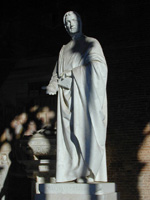 |
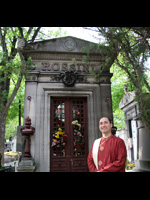 |
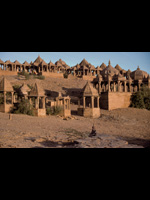 |
|
Fibonacci |
Rossini |
Jaisalmer |
So when we passed a grand cemetery in Granada, I really wanted to visit it – even though there isn’t a mention of it in our guidebook.
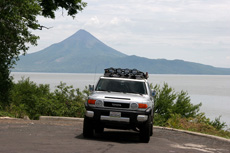 |
|
The Momotombo volcano |
Granada is beautiful. A colonial town on the shores of Lake Nicaragua, with its main plaza dominated by a grand cathedral painted yellow with white trimmings. (My only complaint was a faint smell from the open sewers). Although not on par with the great colonial cities of Central America such as Oaxaca in Mexico and Antigua in Guatemala, it does nevertheless appeal with its numerous churches, gracious internet cafes and lovely old hotels.
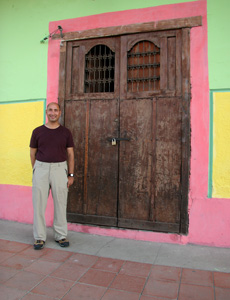 |
|
Shreesh |
But for me the highlight was its cemetery. Although we caught only glimpses of it due to lack of time, it seemed enormous, with its own chapel inside. Shreesh is particularly fascinated by histories of people that you can learn from cemeteries. He was puzzled to find a large number of young people in their twenties buried in the eighties, until we realized that it was the year of the Sandinista revolution. Elaborate structures dominated by domes, crosses and biblical figures housed graves for specific families. Although we couldn’t recognize famous names like Evita in Recoleta or Rossini in Père Lachaise, I am sure that some of the more famous colonial figures are buried there.
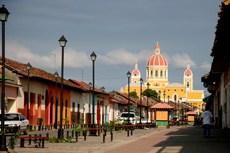 |
|
Calle Calzada |
Whenever we see old ruins, cemeteries or cathedrals, I have to remind myself that the structures we see are of the rich – the houses of the Mayan nobility, the grand palaces of kings and the elaborate graves of the rich. The mud and thatch houses of the poor have been dissolved by time and left to the imagination. Ironically, we found that it is the poor who have survived; the kings were executed, the nobility dissolved and the traditions live on in the common folk in the villages.
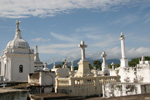 |
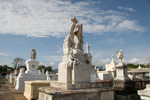 |
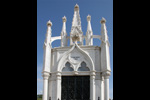 |
|
The cemetery |
The angel |
The house |
You have hit on one of my favorite spots to visit in foreign cities. So, besides good wines and food, Italian literature and skiing, we share interest in cemetaries. One cannot outdo Pere Lachaise on the celebrity count, but my favorites are probably those of the American South: the New Orleans graveyards with their endless avenues of raised houses for the dead and the Savannah one immortalized (ha,ha!) by “Midnight in the Garden of Good and Evil”. The most poignant one , though, which I can think about was that in Mostar in Bosnia, right in the heart of the freshly rebiult Old City, full of graves of young Muslim men killed in mid-90ies.
On an unrelated funerary note, today’s paper announced that doubts have been raised about the identity of pharaoh Tutmos I and Queen Hatshepsut mummies, this trouble being related to DNA testing. If that indeed is true, one could conclude that the old foxes once again outwitted the grave robbers, this time of the archeological persuasion.
I’ve always thought it would be very interesting if each buried individual would have a biography available for visitors. Imagine having Hatshesut’s journals buried with her mummy! In this modern age one could be buried with a digital record of his or her life – or better yet have some sort of terminal attached to the grave so you could learn more about the deceased.
Neena, very interesting post. This is something new to me, but it looks like an interesting option when visiting new places..
Fred, that is an interesting take. Now that you mention it, I think that it is pretty much an eventuality, it’s gonna happen sooner than later.
Hello Jerzy,
Yes , New Orleans cemetery is great too but we haven’t seen the one in Mostar. I remember being moved to tears by one particular grave in Recoleta, that of a young woman, Liliana Cruciati, who was killed on her honeymoon by an avalanche. The father had written a heart rending poem.
A mia figlia
Solo mi chiedo il perché.
Tu sei partita e distrutto hai lasciato il mio cuore
Che te solamente voleva, perché?
Perché? Solo il destino sa il perché e mi domando perché?
Perché non si puo stare senza te, perché?
Tanto bella eriche la natura invidiosa ti distrusse, perché?
Perché solo mi domando se dio c’e, con se porta via cio che suo non’é
Perché mi distrugge e lascia all’infinito dolore!
Perché? Credo al destino e non a te, perché?
Perché solo so che sempre sogno con te, perché c’e di ché?
Per tutto l’amore che sente il mio cuore per té.
Perché? perché?
Il tuo papá
Neena:
Did you ever hook up with any Oracle people in South America? Just curious. You might have mentioned in your posts but I haven’t read all of them. I’m really enjoying reading about your adventures.
Janis
I found the most interesting cemetaries, besides New Orleans, was in Italy. They frequently had a picture of the person embedded in the gravestone. I would sometimes make up stories of their lives based on the age of the person and their picture. In Italy it is also a custom when a relative visits to take them to the cemetary to visit their other relatives.
Hello Janis,
The only Oracle offices in Central America are in Mexico and Costa Rica. We never went to Mexico City, but we did visit the Oracle office in Costa Rica. Enoc was extremely helpful in retrieving some things that we had received from the US from the Costa Rican Customs. Unfortunately, we went to San Jose just as Enoc was leaving for Puerto Rico and we never could meet up with him.
Neena